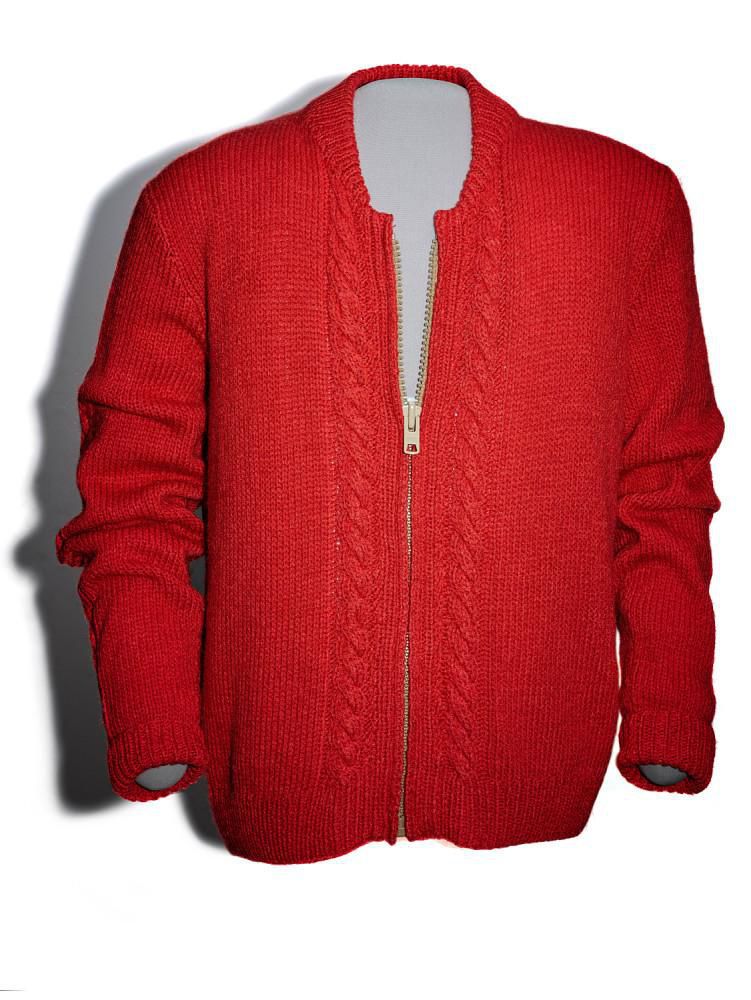The USPS, a $70 soup pot and whole lot of effort went into finding the perfect zip-up cardigan for Fred Rogers

In his three decades on public television, Fred Rogers greeted his neighbors each day with his familiar theme song as he exchanged his leather shoes for sneakers and zipped up one of his trademark cardigans. The sweaters—lovingly knit by his mother—were a cozy and constant presence for his young fans.
Behind the scenes, the production staff of PBS’s Mister Rogers’ Neighborhood had to get creative to keep the classic Fred Rogers’s look alive—a comfy style that Tom Hanks will channel in the upcoming movie, A Beautiful Day in the Neighborhood.
When the show debuted in 1968, Mister Rogers wore button-down sweaters. But by the second season, some zip-up sweaters were added to the rotation—much easier to fasten, says David Newell, who played delivery man Mr. McFeely on the show. During one early episode, Fred buttoned his sweater wrong, but he opted to use the footage anyway. “He wanted to show children that people make mistakes,” Newell recalls in an interview. But zippers were easier to get into, and they didn’t bump against the microphone, so he made the switch.
The centerpiece of the classic Fred Rogers look was his mother’s handiwork — Nancy McFeely Rogers knit the sweaters in a variety of colors, making a new one every Christmas. When his mother died in 1981, the supply of new handknit sweaters dried up. By the early 1990s, after hundreds of tapings, the yarn was wearing thin.
What viewers of Mister Rogers’ Neighborhood never saw was the frantic search his production staff underwent to replace the iconic cardigans before they wore out entirely.
The show was a frugal operation, and the art department didn’t have the resources to replicate the sweaters by hand. “It was a small budget,” says Kathy Borland, the art director for the last decade of the show. “It was a Pittsburgh show, not New York and L.A. He wanted to keep it small and local. It was homey, not show business.
Well-meaning knitters from the Pittsburgh area brought in their best attempts, but they never worked out. “They would come in with the sweater, and I knew it would be wrong,” Borland said. The right sweater had to be easy to zip up and down so he wouldn’t get distracted as he sang ‘It’s a Beautiful Day in the Neighborhood.’ And it had to be a rich color that would pop on camera. “This was a television sweater, not a walking-down-the-street sweater.”
The art department scoured stores and catalogs, but in the early 1990s, men’s zippered cardigans weren’t exactly in fashion. “We couldn’t find them. Nobody wore those zippered sweaters,” said Margy Whitmer, the producer of the show. “They weren’t cool then.”
After striking out at stores, Borland spotted a postal worker on the street wearing a cardigan looked a lot like Fred’s. She asked if she could see the label and jotted down the name of the manufacturer.
This is where the story gets hazy. Borland said she remembers calling the maker of the postal sweaters but doesn’t remember whether she got them from that company or another supplier they recommended.
A+ School and Everyday Apparel, a sweater manufacturer based in Burlingame, California., has supplied the U.S. Postal Service for decades, and Vince Knoss, co-owner of the company, says it is “very possible” that the show’s production staff bought their zip-up cardigans from one of the company’s many distributors around the country. “We always thought Fred Rogers wore our sweaters,” he says but sales records don’t go back far enough to confirm it.
The cardigans themselves give no indication of their source, since Borland had to buy all-white sweaters and remove the labels before dyeing them. She had plenty of experience as a wardrobe designer dealing with massive tasks — for George Romero’s Day of the Dead, she worked on some 500 zombie outfits. To dye Fred’s sweaters, she purchased an industrial sized soup pot from a restaurant supplier and hung them on a clothesline in her backyard. “It was a big decision to buy the pot. It cost $70,” she says. Stirring constantly with a yardstick, she saturated the sweaters in shades of purple, green, red, blue and rust.
Then another problem presented itself—the fabric around the zipper did not absorb the dye. Catherine McConnell, the show’s assistant art director, would fill in the stark white strip with permanent marker. The art department also waxed the zippers for smoother donning and doffing. “Every time he put that sweater on,” Borland says, “my heart would go into my feet.” Once they got a smooth zip on camera in the opening scene, she could relax.
